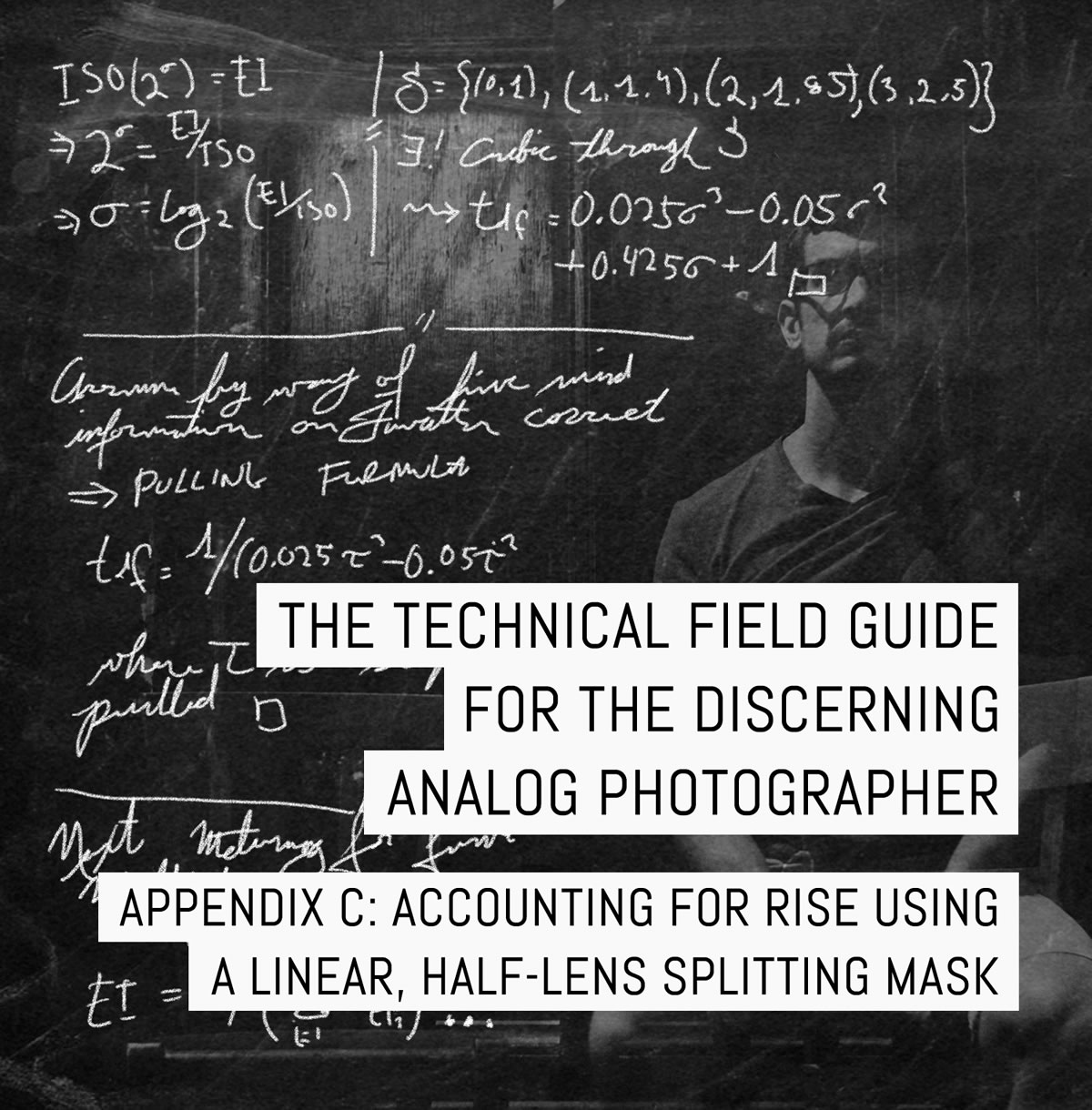In Appendix A I went into greater detail on my equations used for pushing and pulling in the field; and, then, in Appendix B we looked at the equations behind metering for multiple exposures. I am aware, however, that many people purchased my field guide specifically for the sections on splitting masks, as they are (or at least should be) an integral part to any fine art photographer’s workflow.
So, here, in Appendix C of A Technical Field Guide for the Discerning Analog Photographer, I cover a phenomenon you no doubt encountered in the field while shooting with masks.
As mentioned in the main guide (which may be purchased here), using rise with a splitting mask may change what part of the frame the mask effectively “masks”, independent of its position relative to the lens (this can be seen in “figure 1: half-lens rise” below, where the blue dotted line does not correspond to the obscured part of the image).

Appx C, Figure 1: Half-lens rise
The more discerning photographer may want to precisely control this, rather than simply previewing the ground glass with a restricted aperture, as suggested on page 612.
For the sake of simplicity, we’ll make the following assumptions:
- the splitter is centered relative to the lens, on a line drawn perpendicular to the film plane.
- the subject of the photo takes up the entire frame.
- there is no tilt in either the front nor rear standard.
Let be the height of the film,
be the focal length of the lens,
be the distance from
the lens must be for desired focus,
the amount of rise, and
the distance from the lens to the subject,
.
Note: We do not assume to be a function of
and
, as we want to allow for total creative control over the scene (e.g. soft focus, or hyper-focal witchcraftery).
From figure 1, you can clearly see that the exposed portion of the film corresponds to bottom half plus the rise. This gives
as the portion of obfuscated film; and, thus by the law of similar triangles, we have
as the portion of the subject, , which is obfuscated.
Accounting for rise using a circular splitting mask
From “figure 2: circle rise” below, it is clear that the mask diameter, denote , and distance from the lens, denote
, factor into the calculation of filmfuscation.

Appx C, Figure 2: Circle rise
Since there isn’t the same symmetry as in the case of the linear, half-lens mask, we must look at the two parts of the circle mask separately.
Circle mask, part A
Let denote the diameter of the circle of obfuscation from the circle mask, part A. From figure 2, looking at the dashed red line, it’s clear that, from similar triangles, we have
where the center of the circle of filmfuscation is above the center of the film plane.
And, thus, the circle of the subject which is obscured is centered
above the bottom of the frame. And, again by similar triangles, we have a diameter of
for the circle obfuscating .
Circle mask, part B
Left as an exercise to the reader.
Hint: This easily follows as a corollary from the previous calculation
Of course, I failed to include diagrams showing the effect tilt in the rear standard has on circle masks—namely the ovalification of the circle of obfuscation. I invite you to play with this additional phenomenon yourself. Consider it homework until the next appendix drops. Until then, rise to the challenge of making the best possible photos!
~ David
Share your knowledge, story or project
The transfer of knowledge across the film photography community is the heart of EMULSIVE. You can add your support by contributing your thoughts, work, experiences and ideas to inspire the hundreds of thousands of people who read these pages each month. Check out the submission guide here.
If you like what you’re reading you can also help this passion project by heading over to the EMULSIVE Patreon page and contributing as little as a dollar a month. There’s also print and apparel over at Society 6, currently showcasing over two dozen t-shirt designs and over a dozen unique photographs available for purchase.








One response to “Appendix C of the Technical Field Guide for the Discerning Analog Photographer: Accounting for rise using a linear, half-lens splitting mask”
@DBloomsday 2 cups of tea will not be enough to help me understand this… F ♾ to represent the focal… https://t.co/ZdDJEMlhNw